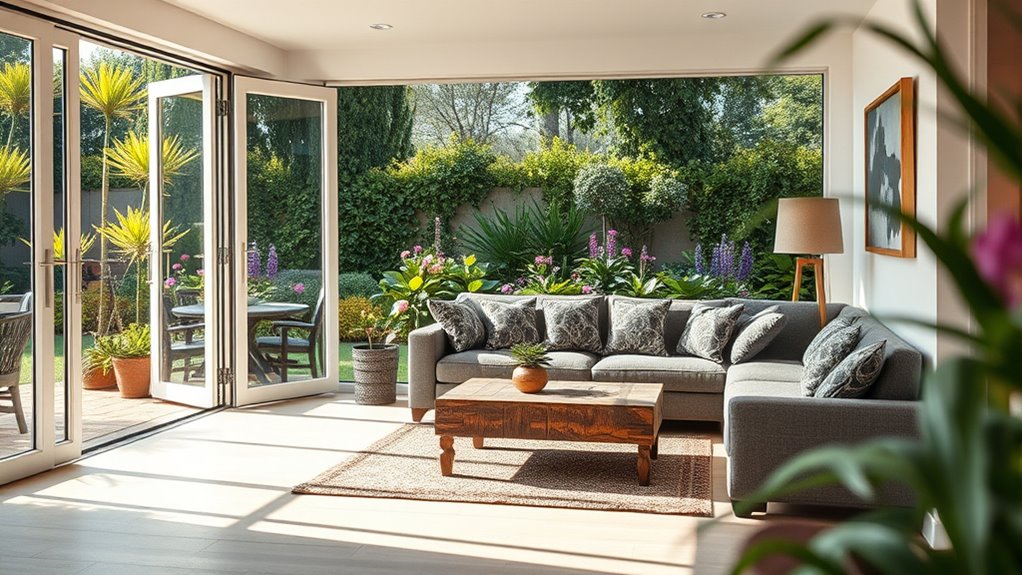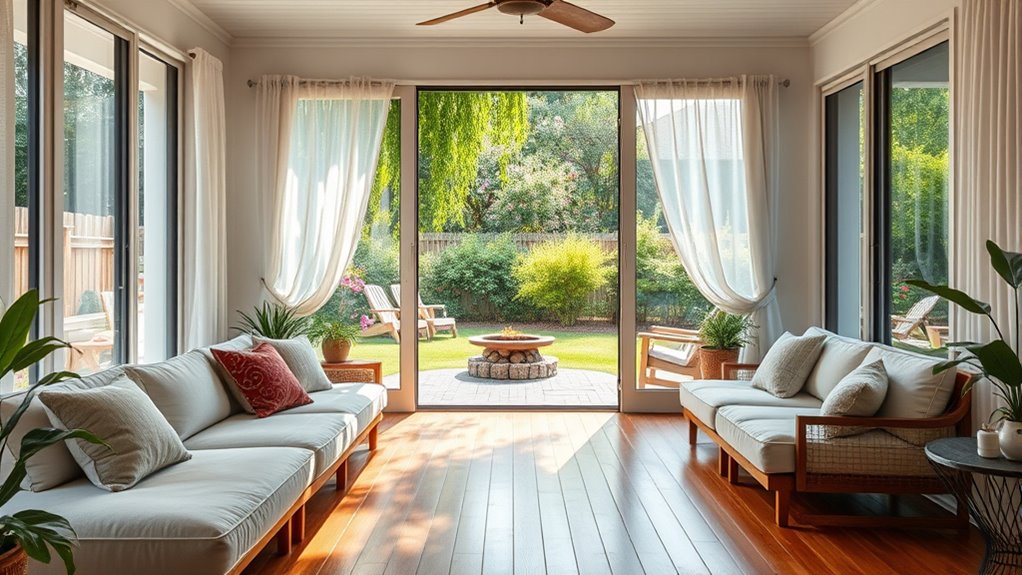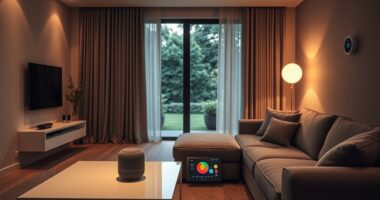To blur the lines between your home and garden, focus on creating visual and structural harmony. Use consistent colors, textures, and decor styles inside and outside. Install large glass doors or folding walls to open up your space. Incorporate soft lighting and lush greenery to extend your living area outdoors. Choose furniture that complements both environments for a seamless flow. Keep exploring how these elements can transform your space into a stunning indoor-outdoor retreat.
Key Takeaways
- Use consistent color schemes, materials, and textures to create visual harmony between indoor and outdoor spaces.
- Incorporate large sliding doors or folding walls to seamlessly connect interiors with gardens.
- Extend lighting design outdoors with string lights and lanterns to unify the ambiance.
- Select plants and decor that thrive both indoors and outdoors to reinforce the natural link.
- Choose furniture and accessories that complement interior styles for a cohesive living environment.

Have you ever wondered how to seamlessly blend your indoor and outdoor spaces? Creating a fluid connection between your home’s interior and garden can transform your living experience, making your entire property feel more expansive and inviting. The key lies in thoughtful garden design that complements your indoor style and careful furniture selection that bridges both environments. When planning your outdoor area, consider how the garden design can mirror the aesthetics inside your home. Use consistent color schemes, materials, and textures to establish harmony. For instance, if your interior boasts sleek, modern furniture, choose outdoor pieces with clean lines and contemporary finishes. Conversely, if your home leans toward a cozy, rustic vibe, incorporate natural wood furniture and earthy tones into your garden furniture selection.
Think about how your outdoor space flows into your indoor living area. Large sliding glass doors or folding walls can open up your interior to the garden, making the boundary almost disappear. When the connection is seamless, it encourages you to spend more time outside, whether you’re hosting friends or enjoying a quiet evening alone. To enhance this link, opt for garden furniture that complements your indoor decor. For example, if you have a minimalist interior, select sleek metal or resin chairs and tables for your patio. If your home is more traditional, consider wicker or wooden furniture that adds warmth and charm.
Create a seamless indoor-outdoor flow with matching furniture and large glass doors for a harmonious living experience.
Lighting plays an essential role in blurring the lines between inside and out. Use soft, ambient lighting both indoors and outdoors to create a unified atmosphere. String lights, lanterns, or recessed lighting can extend the aesthetic of your interior into the garden, making the connection feel natural and inviting. Incorporating plants that thrive in both environments also helps reinforce the link. Hardy, lush greenery can be placed near windows and around outdoor seating areas, acting as a visual bridge. Additionally, selecting rustic decor elements can further unify the theme and enhance the cozy, inviting feel of your combined space.
Lastly, pay attention to the details in furniture selection. Comfortable, durable outdoor furniture allows you to use your garden as an extension of your living room. Cushions that match your interior cushions or pillows with similar patterns can tie the spaces together visually. When your garden design and furniture choices work harmoniously, your home becomes a sanctuary where the boundary between inside and outside simply fades away. The result is a versatile, beautiful space that invites you to live more fully, outdoors and indoors, without feeling like you’re switching environments.
Frequently Asked Questions
How Can I Maintain Privacy in an Open-Concept Outdoor Space?
To maintain privacy in your open-concept outdoor space, you can add privacy screens or outdoor curtains. Privacy screens are great because they create a barrier while still looking stylish, and outdoor curtains can be easily drawn when you want seclusion. Position these elements strategically around seating areas or along fences to block views without sacrificing the open feel. This way, you enjoy your outdoor space comfortably and privately.
What Are the Best Weatherproof Materials for Outdoor Furniture?
When choosing outdoor furniture, you want materials that’ll withstand the elements. Imagine hosting a summer party; your weatherproof furniture stays pristine. For durability, opt for weather resistant fabrics like synthetic wicker or acrylic cushions, and corrosion proof metals such as aluminum or stainless steel. These materials resist rain, sun, and humidity, ensuring your outdoor space stays stylish and functional year-round.
How Do I Integrate Smart Technology Into Indoor-Outdoor Areas?
You can easily integrate smart technology into your indoor-outdoor spaces by adding smart lighting and automated shading. Use smart lighting systems to control ambiance effortlessly, adjusting brightness and color from your device. Automated shading helps regulate sunlight and privacy, creating a seamless crossover between indoors and outdoors. These features enhance convenience, comfort, and energy efficiency, making your space more functional and enjoyable, no matter the weather or time of day.
What Safety Considerations Are Important for Outdoor Living Spaces?
You should prioritize fire safety by keeping grills and heaters away from structures and clearing dry leaves or debris. Protect wildlife by avoiding toxic plants and using bird-friendly lighting. Guarantee outdoor electrical outlets are weatherproof and grounded to prevent shocks. Regularly inspect furniture and fixtures for damage, and install proper lighting for visibility. These precautions help create a safe, enjoyable outdoor space while respecting the environment.
How Can I Create Seamless Flooring Transitions Between Indoors and Outdoors?
To create seamless flooring crossings, focus on threshold alignment, ensuring the passage between indoor and outdoor spaces is smooth and level. Choose compatible flooring materials that complement each other in texture and color, such as stone outside and tile inside. Use flush thresholds or transition strips that blend well, preventing tripping hazards. This approach enhances flow and safety, making your space feel unified and inviting.
Conclusion
By blending indoor and outdoor spaces, you create a seamless tapestry where your home breathes with the garden’s vibrancy. Imagine your living area as a welcoming bridge that invites nature’s colors and sounds inside, transforming your everyday routine into a vibrant dance between comfort and wilderness. This harmony turns your home into a living canvas, where the boundaries dissolve like mist at dawn, revealing a sanctuary that’s always connected to the natural world outside.









